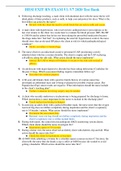Exam (elaborations)
MNM3709 Assignment 3 (COMPLETE ANSWERS) Semester 2 2024 - DUE 1 October 2024 ; 100% TRUSTED Complete, trusted solutions and explanations.
MNM3709 Assignment 3 (COMPLETE ANSWERS) Semester 2 2024 - DUE 1 October 2024 ; 100% TRUSTED Complete, trusted solutions and explanations.
[Show more]












